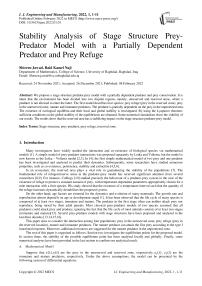Stability Analysis of Stage Structure Prey-Predator Model with a Partially Dependent Predator and Prey Refuge
Автор: Shireen Jawad, Raid Kamel Naji
Журнал: International Journal of Engineering and Manufacturing @ijem
Статья в выпуске: 1 vol.12, 2022 года.
Бесплатный доступ
We propose a stage structure predator-prey model with a partially dependent predator and prey conservation. It is taken that the environment has been divided into two disjoint regions, namely, unreserved and reserved areas, where a predator is not allowed to enter the latter. The first model describes four species: prey refuge (prey in the reserved zone), prey in the unreserved zone, mature and immature predators. The predator is partially dependent on the prey in the unprotected area. The existence of ecological equilibria and their local and global stability is investigated. By using the Lyapunov theorem, sufficient conditions on the global stability of the equilibriums are obtained. Some numerical simulations show the viability of our results. The results show that the reserved area has a stabilizing impact on the stage structure predator-prey model.
Stage-structure, prey-predator, prey refuge, reserved zone
Короткий адрес: https://sciup.org/15018287
IDR: 15018287 | DOI: 10.5815/ijem.2022.01.01
Список литературы Stability Analysis of Stage Structure Prey-Predator Model with a Partially Dependent Predator and Prey Refuge
- S. Jawad, “Stability Analysis of Prey-Predator Models with a Reserved Zone and Stage Structure,” Univ. Baghdad, Coll. Sci. Dep. Math., 2009.
- A. J. Lotka, “Elements of physical biology,” Sci. Prog. Twent. Century, vol. 21, no. 82, pp. 341–343, 1926.
- V. Volterra, “Variazioni e fluttuazioni del numero d’individui in specie animali conviventi,” 1926.
- S. Jawad, “Modelling, dynamics and analysis of multi-species systems with prey refuge.” Brunel University London, 2018.
- N. Ali, M. Haque, E. Venturino, and S. Chakravarty, “Dynamics of a three species ratio-dependent food chain model with intra-specific competition within the top predator,” Comput. Biol. Med., vol. 85, pp. 63–74, 2017.
- S. Jawad, D. Sultan, and M. Winter, “The dynamics of a modified Holling-Tanner prey-predator model with wind effect,” Int. J. Nonlinear Anal. Appl., vol. 12, no. Special Issue, pp. 2203–2210, 2021.
- P. T. Saijnders and M. J. Bazin, “On the stability of food chains,” J. Theor. Biol., vol. 52, no. 1, pp. 121–142, 1975.
- B. Dubey, “A prey-predator model with a reserved area,” Nonlinear Anal. Model. Control, vol. 12, no. 4, pp. 479–494, 2007.
- V. Křivan, “Effects of optimal antipredator behavior of prey on predator–prey dynamics: the role of refuges,” Theor. Popul. Biol., vol. 53, no. 2, pp. 131–142, 1998.
- J. B. Collings, “Bifurcation and stability analysis of a temperature-dependent mite predator-prey interaction model incorporating a prey refuge,” Bull. Math. Biol., vol. 57, no. 1, pp. 63–76, 1995.
- V. H. W. Rudolf and K. D. Lafferty, “Stage structure alters how complexity affects stability of ecological networks,” Ecol. Lett., vol. 14, no. 1, pp. 75–79, 2011.
- N. Mondal, D. Barman, and S. Alam, “Impact of adult predator incited fear in a stage-structured prey–predator model,” Environ. Dev. Sustain., vol. 23, no. 6, pp. 9280–9307, 2021.
- J. Li, X. Liu, and C. Wei, “The impact of role reversal on the dynamics of predator-prey model with stage structure,” Appl. Math. Model., 2021.
- T. K. Kar and U. K. Pahari, “Modelling and analysis of a prey–predator system with stage-structure and harvesting,” Nonlinear Anal. Real World Appl., vol. 8, no. 2, pp. 601–609, 2007.
- M. Dorato, “Mathematical biology and the existence of biological laws,” in Probabilities, Laws, and Structures, Springer, 2012, pp. 109–121.
- M. Dorato, “Mathematical biology and the existence of biological laws,” in Probabilities, Laws, and Structures, Springer, 2012, pp. 109–121.


